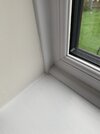Daughter's house has uPVC double-glazing throughout that's probably 10-15 years old (fitted for the previous owners, before they bought the house).
Doesn't seem anything serious wrong with it, reasonably wide gap between panes, no internal condensation etc but it wasn't well finished by the fitters on the inside. The filler is cracking and generally a bit tired. Before they decorate, I thought to tidy up the appearance for them, maybe with "cloaking fillet" e.g. https://www.eurocell.co.uk/trims-an...and-angles/30mm-cloaking-fillet-in-white-x-5m
According to pictures I found here e.g. https://www.tradesuperstoreonline.co.uk/products/30mm-cloaking-fillet-x-5m this is supposed to be mounted with the width onto the frame, rather than the walls & sills.
However the fitters did it differently more recently (about 4 years ago) with our house (see photo) and (apart from very minor cracks I need to fill !!), the appearance is actually quite nice I think, combined with the quadrant finish on the sill. Would appreciate your comments.
Doesn't seem anything serious wrong with it, reasonably wide gap between panes, no internal condensation etc but it wasn't well finished by the fitters on the inside. The filler is cracking and generally a bit tired. Before they decorate, I thought to tidy up the appearance for them, maybe with "cloaking fillet" e.g. https://www.eurocell.co.uk/trims-an...and-angles/30mm-cloaking-fillet-in-white-x-5m
According to pictures I found here e.g. https://www.tradesuperstoreonline.co.uk/products/30mm-cloaking-fillet-x-5m this is supposed to be mounted with the width onto the frame, rather than the walls & sills.
However the fitters did it differently more recently (about 4 years ago) with our house (see photo) and (apart from very minor cracks I need to fill !!), the appearance is actually quite nice I think, combined with the quadrant finish on the sill. Would appreciate your comments.
Attachments
Last edited:


